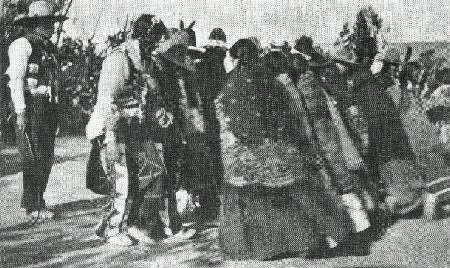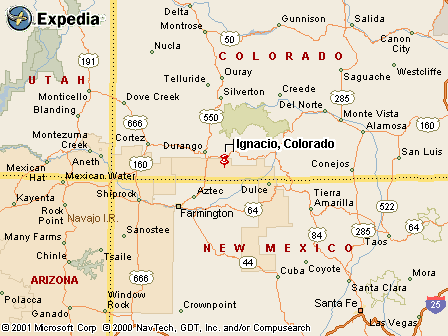|
|
Canku Ota |
|
|
(Many Paths) |
||
|
An Online Newsletter Celebrating Native America |
||
|
June 1, 2002 - Issue 62 |
||
|
|
||
|
'Cub reporter' Tries His Hand at Southern Ute's Bear Dance |
||
|
by Brian Newsome Durango
Herald Staff Writer
|
||
|
credits: Photo
image of early Southern Ute Bear Dance
|
 IGNACIO,
CO - "You with the notebook," a man said over the loudspeaker.
I looked around. People conversed, dined or just stood around, but
no one had a notebook. "Come in and take a seat," he said. IGNACIO,
CO - "You with the notebook," a man said over the loudspeaker.
I looked around. People conversed, dined or just stood around, but
no one had a notebook. "Come in and take a seat," he said.
This was the beginning of my first Bear Dance. I walked hesitantly into the corral – the Southern Ute Indian Tribe holds its annual Bear Dance there to celebrate spring – as Bear Dance chief Rudley Weaver, sub-chief Byron Red Sr., accompanying musicians and spectators looked on. Timidly taking a seat near the front, I put my notebook down to listen. The growlers, rumbling percussion-style instruments, thundered as the dance leaders sang. Relaxing a bit, I tapped my foot. Then, they came. Southern Ute tribal members Liz Kent and Alice Red approached me, wearing traditional Bear Dance attire of a shawl and dress. Kent, a lifetime Bear Dancer, pointed at me and I knew I was in trouble, panicking over my two left feet. Red grabbed a seasoned dancer. Normally crowded with dancers – the four-day Bear Dance typically brings in several hundred people including many from other tribes – the corral floor was empty for opening night, known as the warm-up night, and this reporter was the opening act. The line dance was simple for those who have rhythm. Left foot front, right foot up, left foot back and repeat. For me, it might as well have been advanced tap. Still, my partners were gracious with me. Perhaps too gracious, since I was called for a repeat performance minutes later. Because the Bear Dance is a sacred celebration, cameras were not allowed (a good thing for me). But despite my ineptitude, I could feel the spirit of the dance in the rumbling of growlers and the heart-felt songs, passed down for generations. Weaver, who has served as the dance’s chief for four years, spoke about the Bear Dance before my debut. Growing up with the dance under the tutelage of his grandfather, Weaver said the event is a time for family and friends to get together, sing, dance and celebrate spring. "You dance, you laugh, you crack jokes," he said. "It’s reaffirming our bond to each other as a people." Other Ute tribes, Apache tribal members, and non-Indian people all come to the dance, he said. The Southern Ute Tribe also participates in the Bear Dances for other Ute tribes, the Northern, Ute Mountain and White Mesa Utes. "You get to meet your families from the other bands," Weaver said. Not everyone who attends the dance will participate, he said. Some just come to watch, as I had expected to do. I interviewed Anglo-attendee Bear Limvere, of Elbert, who has traveled to the dance for almost a decade. He was selected to dance after yours truly, in which he promptly showed me up. Originally hearing about the event at a Denver powwow, he keeps coming back for "the whole experience" and the "connectiveness." Mustering up courage after my humbling performance, I also spoke with onlooker Geri Julian, an Apache from Dulce. Her grandmother and great-grandmother would travel to the Southern Ute Bear Dance by wagon. The Apaches were allies of the Southern Utes and would travel to the Bear Dance regularly. The tradition is still honored, with the Apache Jicarilla wagon trek, which has been working its way toward Ignacio for the past few days. It is expected to arrive at the Bear Dance camping grounds around 2 p.m. today. Julian said she enjoys watching the dancing and told me of similar Apache dances. Legend says the Bear Dance began when two brothers were out hunting and encountered a bear that seemed to be dancing and making noise while clawing a tree. One brother continued hunting, while the other stayed to observe the bear. The bear taught him the dance and an accompanying song. Since then, the dance has served to celebrate spring and bring spiritual renewal. If you go, here are a few rules of etiquette: |
|
|

|
www.expedia.com |
|
|
||
|
|
||
| Canku Ota is a free Newsletter celebrating Native America, its traditions and accomplishments . We do not provide subscriber or visitor names to anyone. Some articles presented in Canku Ota may contain copyright material. We have received appropriate permissions for republishing any articles. Material appearing here is distributed without profit or monetary gain to those who have expressed an interest. This is in accordance with Title 17 U.S.C. Section 107. | ||
|
Canku Ota is a copyright © 2000, 2001, 2002, 2003 of Vicki Lockard and Paul Barry. |
||
 |
 |
|
|
The "Canku Ota - A Newsletter Celebrating Native America" web site and its design is the |
||
|
Copyright © 1999, 2000, 2001, 2002, 2003 of Paul C. Barry. |
||
|
All Rights Reserved. |
||